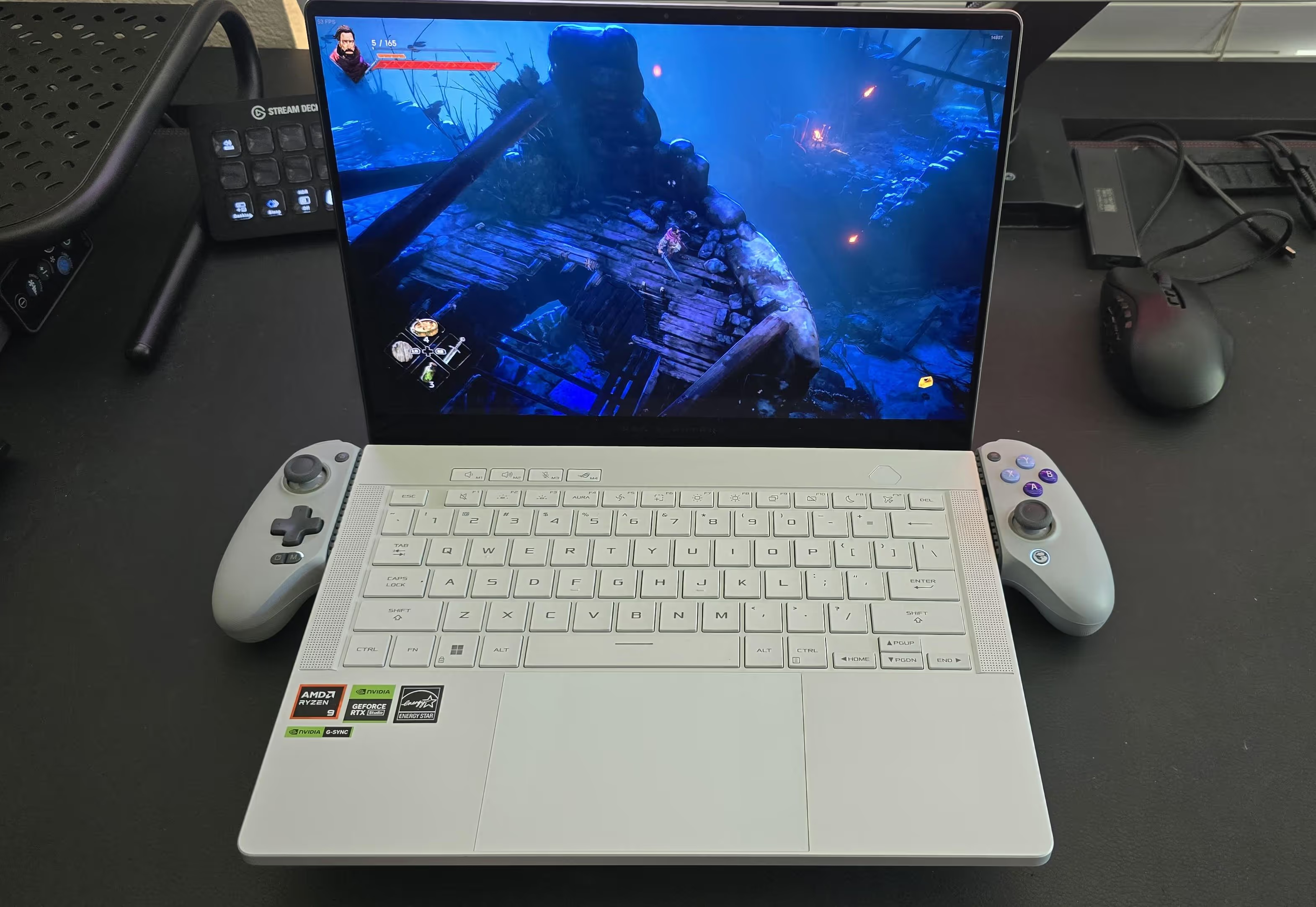
Over the last year I’ve personally tested 40+ laptops and tablets to answer one question: What’s the best 14‑inch gaming laptop that can double as a handheld gaming device? I wanted AAA performance and multi‑use flexibility that handhelds like the Steam Deck or ROG Ally can’t match at the settings I want to play at—while still working as a full Windows laptop for creation, school, and business. Each device was evaluated through hands‑on play for gaming performance, display quality, and—most importantly—peak brightness, because brightness drives visibility in bright rooms and on the go and makes handheld‑style play comfortable. The recommendations that follow come from first‑hand, side‑by‑side testing. When I call a model the best 14‑inch gaming laptop or the top pick for handheld‑style PC gaming, it’s based on hours of tuning and comparison so you can choose with confidence.
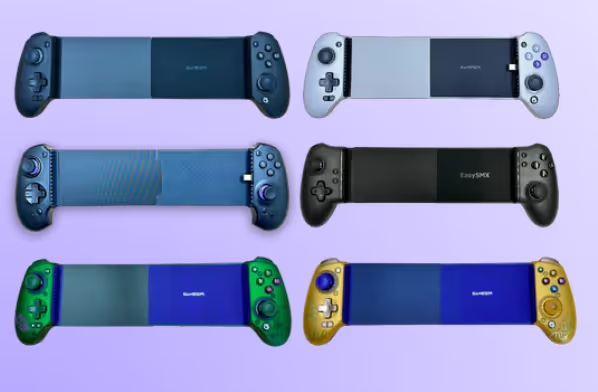
GameSir G8 Plus Extension Controller Mod (RRtronics) — If you want true handheld gaming on a 14‑inch laptop (or a tablet), this is the accessory that makes it possible. The RRtronics‑modded GameSir G8 Plus expands to fit everything from an 11‑inch iPad up to a 16‑inch laptop (the 16‑inch is usable but a bit less comfortable due to weight distribution), effectively turning your device into a Switch‑style handheld gaming PC with full‑size controls.
There is a USB‑C version for a direct, low‑latency wired connection, or the Bluetooth version. You get console‑grade haptic feedback that lets you feel realistic vibrations, ergonomic Xbox‑like grips for all‑day comfort, and rear mappable paddles positioned for your ring fingers so you can trigger actions without lifting your thumbs. In short, this extension controller bridges the gap between PC power and handheld convenience.
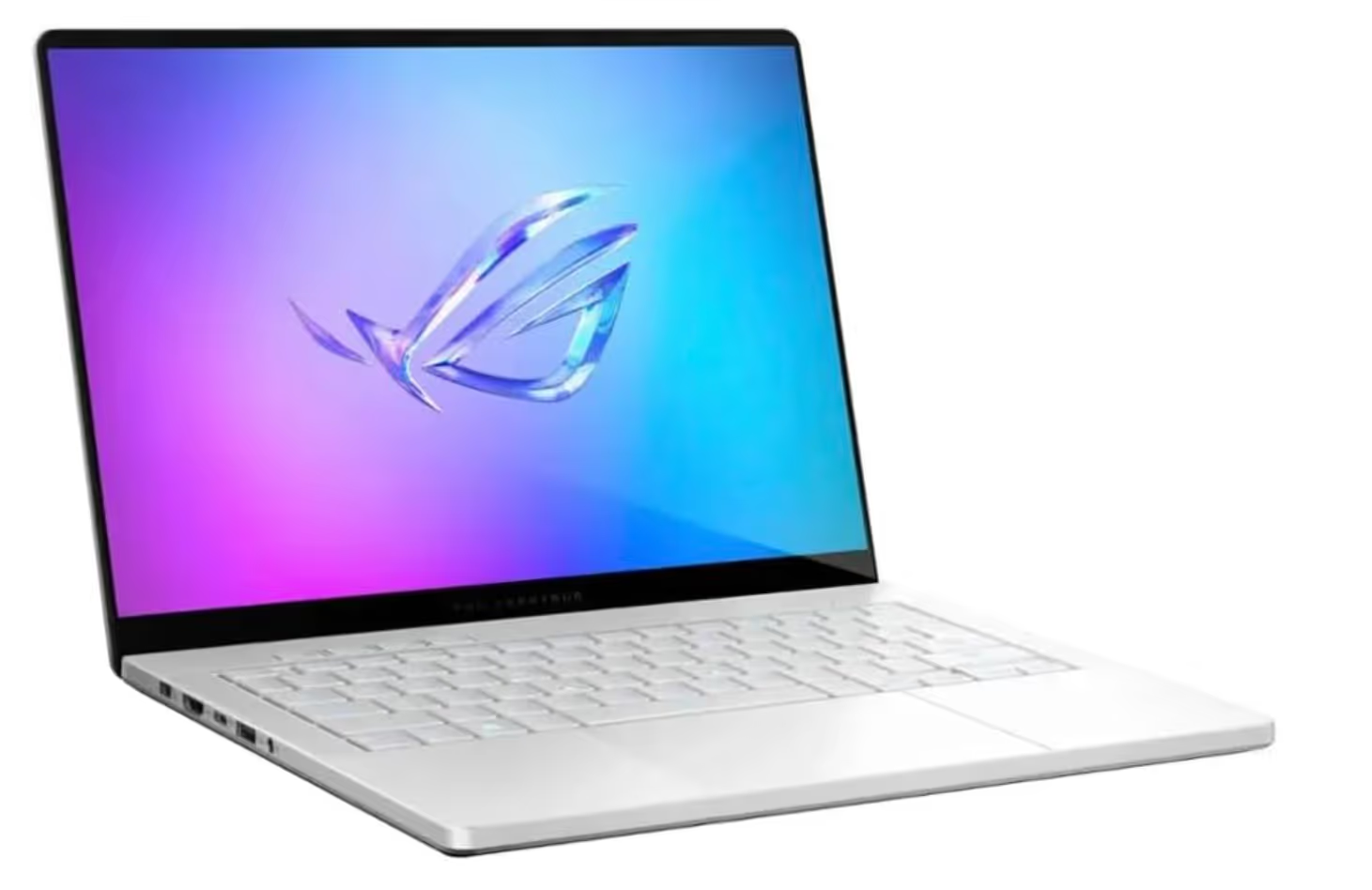
The 14-inch ASUS ROG Zephyrus G14 is my favorite gaming laptop in the 14-inch category by far. It might be a little more spendy than other options, and it’s definitely the most premium, but when you buy this one you’re getting the best overall experience of any laptop on the market.
You could buy the previous 2024 model with an NVIDIA 4000-series GPU. It’s good, but it’s harder to find now—you might spot one on eBay or Facebook Marketplace. Most of the time, I’d still recommend buying the newest G14 because you get significantly better performance thanks to the software it enables. The 5000-series cards support multi-frame generation—2×, 3×, or 4× the frames—and in select games that can effectively quadruple your FPS. The 4000-series does have 2× frame generation, which is definitely good enough, but for future-proofing, I’d go with the newest version.
Bottom line: if you want the strongest long-term gaming performance in a 14-inch gaming laptop, get the latest G14 with the 5000-series GPU.
Gaming performance on the G14 is excellent. In the 14-inch category, it’s the most performant of the bunch. Compared to a PS5, it’s about 20% faster in raw power. And because this laptop runs an NVIDIA GPU, you also get AI upscaling and frame generation, so the real-world performance difference is much bigger—higher settings, higher resolutions, and higher frame rates than a PS5 thanks to the software you get with NVIDIA.
If you use the PS5 as a reference point, this will give you a noticeably better gaming experience than any console on the market right now.
Now, the display. The OLED panel is excellent. Peak brightness is around 500 nits, which is great in a room—and especially at night. In a brightly lit space or direct sunlight, it might be a little harder to see, but in 90% of situations you’ll be totally fine and absolutely love this screen. You get that deep OLED contrast and excellent color. Once you go OLED, there’s really no going back.
Here’s the battery story. It uses an AMD CPU, and those are known for efficiency. The laptop actually has two GPUs:
On battery, it’s way more efficient to use the iGPU. The dGPU will drain the battery quickly—you’ll run out in about an hour or so while gaming. On the iGPU, you can usually play for two to three hours or more, depending on the game.
For a reference point, the iGPU is about 30–40% faster than a Steam Deck. You’ll play most games at low settings and low resolutions, and indie titles at high settings and high resolutions—it depends entirely on the game. Older titles and indie games are going to play amazingly on the iGPU; newer AAA games are not. When you want to play newer games, it’s as simple as plugging in. Then you have access to all the power from the RTX 5070 Ti and you can play every single game on the market at high settings, high frame rates, and high resolutions.
That pattern—iGPU on battery for efficiency, dGPU plugged in for max power—is pretty much true for all devices you’d look at in this space. That’s the ruler I go by.
For a Windows device, these are the best speakers you’ll get on any Windows laptop. They sound amazing—full, with good bass. There are speakers firing from the top and the bottom, so you get a real soundstage. On a table where the sound can bounce and reflect, you can hear effects coming from the left and right. It’s cool, and it actually works.
This is why I’d choose a laptop over a dedicated gaming handheld: you can still use it as a handheld. With a GameSir extension controller, you can hold it close to your body like a handheld, and when you’re done, you’ve got a larger screen for movies, work, or browsing. It’s a multi-use device in a way a Steam Deck or ROG Ally just can’t match. I believe the best option for a handheld-style gaming experience is a 14-inch gaming laptop with that GameSir extension controller—and as you can see in the picture above, it’s totally doable.
If you’re out in public and constantly on the go, that’s where this setup gets tricky. In that scenario, a smaller gaming handheld like a Steam Deck is better. But if you’re mainly at home and want to relax in bed or on the couch, the 14-inch gaming laptop is the ideal choice. That’s where it wins and where you’ll notice the biggest difference.
It’s an amazingly well-built device—sturdy and solid. The keyboard deck is great, and the keys are very satisfying to type on.
You can also use this for more than gaming. If you’re doing content creation or you’re a streamer, you can play in a handheld style and stream at the same time. On a dedicated handheld, that’s much harder because of the hardware limitations in a smaller device.
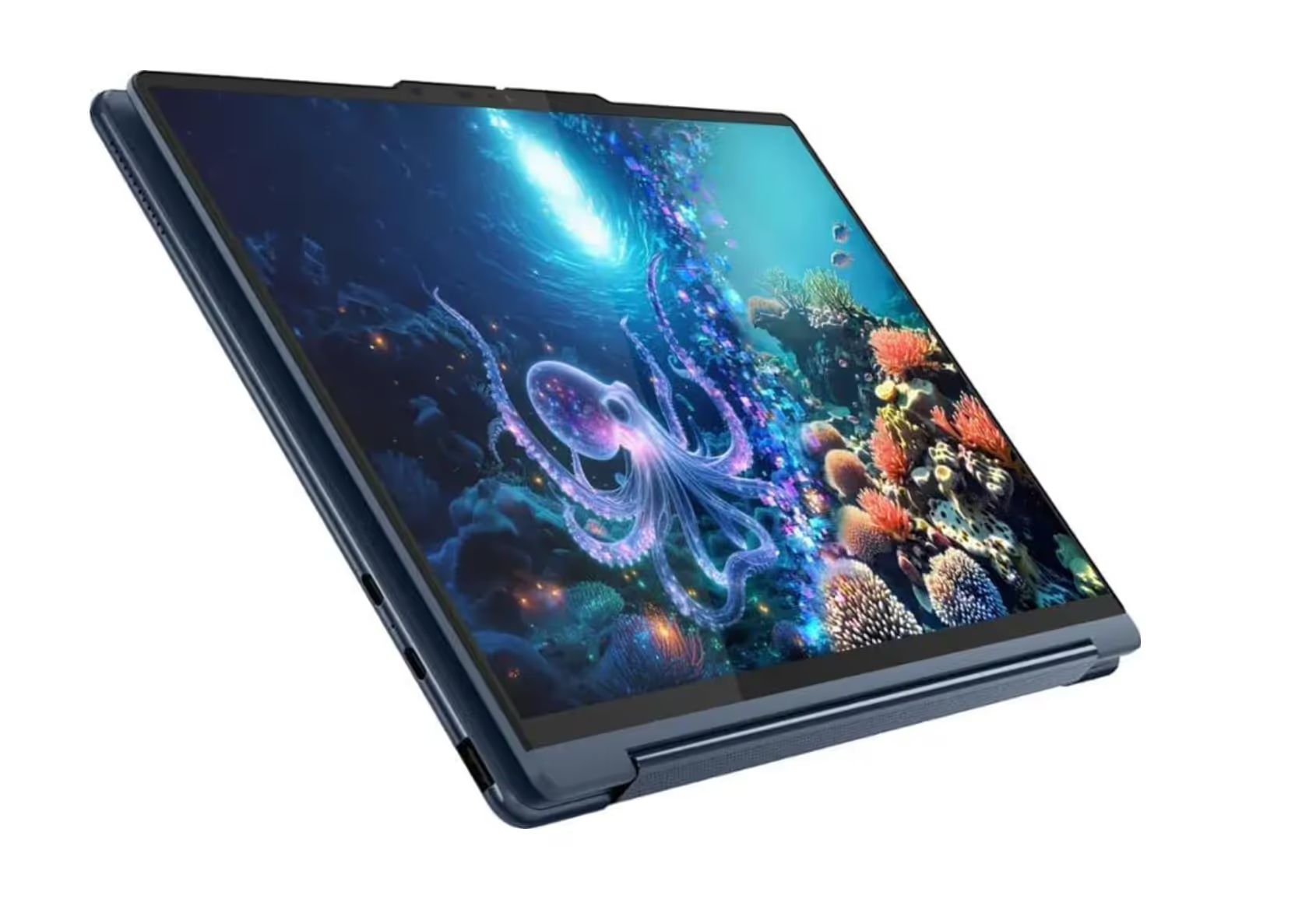
This next device is the Lenovo Yoga 9i 2-in-1 Aura Edition. It’s a little unique and different in that it does not have a dedicated GPU like the G14. It only has an integrated GPU—less powerful but more efficient—and there are tradeoffs that might make that worth it.
The reason I chose this device is simple: if you already have a gaming desktop at home with all your main games—the AAA, most demanding titles you want to run at the highest settings—you’ll play those at home on the desktop. When you’re away from home, you’ll want to play 2D games, indie games, and less demanding 3D games. Things you’re not necessarily trying to max out while you’re on the go. Examples:
Those kinds of games run pretty well on an integrated GPU, especially if you’re okay with lower settings and lower resolutions. Performance is typically on par with the integrated performance of the G14, and as a reference point you’ll get about 30–40% better than a Steam Deck. That gives you a solid idea of what to expect here.
Now, the display. The OLED panel is the star, and it’s the best screen on this entire list for me. It’s about 50% brighter than the G14’s display and can hit up to 1100 nits. It’s absolutely beautiful and you’ll notice it while gaming. It’s also fantastic for movies and media—deep contrast, vivid color, and the brightness to make it pop.
Another big advantage—and this is what I do—is streaming games from my desktop to this device. I use all the horsepower of my RTX 5090 desktop while playing locally on the couch, in bed, wherever. It feels like I’m playing on my desktop, just sitting wherever I want.
I’ll link them here so you can find them. They let you play your desktop games on the laptop with very little compression—not noticeable unless you’re really pixel-peeping—and at the highest settings your desktop allows.
When you go out and you’re not trying to play the most demanding games, this device is still capable of running your Steam games and giving you the experiences you want. It’s not the most powerful option, but it’s a relatively good experience—better than basically any gaming PC handheld out now, or any Android handheld you’d play on your phone.
Let’s talk audio. The speakers are very good. They’re not as good as the G14’s, but you’d really only notice that if they were side by side. On their own, they’re enjoyable and deliver a great experience for games and movies. You won’t feel like you’re missing anything.
Battery life is one of the best parts of this 2-in-1 laptop. Without a dedicated GPU draining power, you can expect about 2–3 hours of gaming on the integrated GPU, and around 12–15 hours of general use before the battery dies. It’s a very versatile device because of that.
One of the coolest things here is that it’s a 2-in-1. It folds 360° onto itself, so you can play as if it were a true handheld. On the G14, a controller attaches to the keyboard deck and the display sits at an angle. With the Yoga 9i, you can fold the screen all the way back, attach your controller, and play like a Nintendo Switch or any other gaming PC handheld. It’s very cool, very effective, and it genuinely feels like a handheld, not a laptop.
This is especially great if you’re streaming from home: you get a big, bright OLED with good audio, playing at the highest settings your PC can handle—right in your hands. That’s a PC handheld experience. It’s one of my absolute favorite ways to play PC games and my Steam library.
And beyond gaming, you’ve got full Windows here. Video editing, content creation, coding, programming, web browsing, business tasks—it handles all of that too, just like the G14. It’s a multi-use, multi-purpose device, which is exactly what I want in this category.
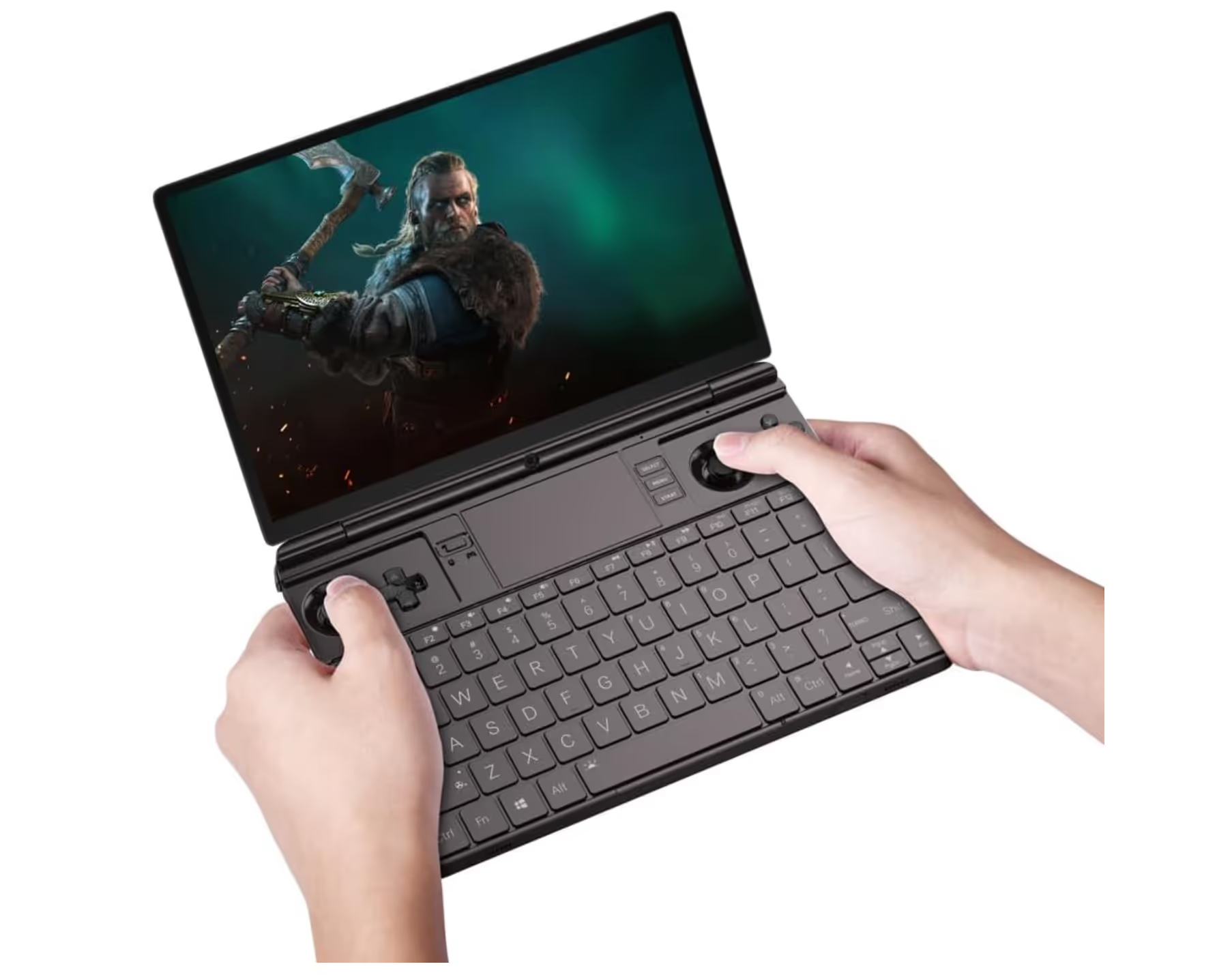
The next device on here is the GPD Win Max 2, and it comes in a whole bunch of different variants. Which one you buy matters, but the 2025 models come with either the AMD Ryzen AI 9 HX 370 or the Ryzen 8840U. Both are very proficient for gaming. The HX 370 version is about 15% better than the 8840U version, but it costs about 25% more. It really depends on what you want and how you value that trade-off. Honestly, the 8840U is a great option—especially if you’re playing most of your big AAA games at home, and on the go you’re sticking to more portable-friendly titles: indie games, older AAA games, 2D games, things like that. That’s where this type of handheld gaming PC shines.
It can still hit some big hitters. You can play Horizon, Forza Horizon 5, Cyberpunk, and similar titles—just understand those are better optimized for handhelds with lower-powered GPUs and CPUs, so you’ll tune settings accordingly. Versus a Steam Deck, you’re looking at about 30% better with the HX version and about 15–20% better with the 8840U version. Both of those are respectable.
The main draw here is the clamshell laptop form factor with a built-in controller. This “laptop” is actually a gaming handheld: it has left and right triggers, bumper buttons, joysticks, a D-pad, and face buttons—a full controller layout. It also has a laptop keyboard deck with all the keys and a touchpad at the top portion of the keyboard deck. It’s a true 2-in-1: gaming laptop and gaming handheld.
The display is a 10.1-inch, 16:10 panel. Here’s the only bad part in my opinion—and other people may not share this take, so it’s up to what you value. It’s an IPS display, not OLED, and it’s 60 Hz, not 120 Hz. That might be a deal breaker for you. That said, the panel they’re using is high quality—the colors look good, it’s nice and crisp. It won’t match OLED, but if that’s not a big deal to you, this can still be a great display on a great device.
This is meant to be used portably, so the battery life is great. Expect about 2–3 hours of gaming, and 10–15 hours if you’re doing light tasks on the laptop itself.
The speakers are usable—good, not great. You’ll probably want headphones or earbuds for the best audio, but if you don’t have them, the speakers work in a pinch. My experience: I didn’t mind them; they worked just fine. I didn’t love them, but I didn’t dislike them either, and once I started playing I didn’t think about it much—and I’m someone who really enjoys a good auditory experience when I’m playing video games.
There is another downside: if you have any troubles with the device, you’ll basically need to send it back to the factory in China for repairs, or they’ll send you parts so you can do the repair yourself. It’s a little more involved. I’ll say I never had any issue with my unit, and it’s not super common, but it’s something to consider when you’re buying from a third party like this—there are some trade-offs in post-purchase support.

The TUF Gaming A14 is the premium‑budget sweet spot for shoppers targeting $1,000–$1,400. AMD’s Ryzen 8845HS provides ample CPU performance for school, business, coding, and video editing, while the RTX 4060 (a worthwhile step up from the 4050) delivers strong 1080p–QHD‑class results with some tweaked settings. It won’t match the Zephyrus G14’s newest‑gen dGPU, but it runs the vast majority of modern games smoothly if you dial in resolution and quality appropriately.
The 14‑inch 16:10 IPS panel brings a fast 165Hz refresh for esports responsiveness, and its matte finish helps tame reflections in bright rooms. Battery life around 6–8 hours is serviceable for a day with a charger nearby, and the integrated Radeon 780M lets you save power for light gaming on battery. If you want a capable, budget gaming laptop with a few compromises, this is the value leader.